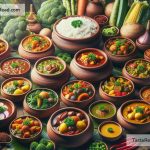How the Sri Lankan Hoppers Became a Breakfast Delight
Sri Lanka, an island nation rich in culture and tradition, has long been cherished for its incredible cuisine that combines flavors, spices, and cooking techniques inherited from various influences including Dutch, Portuguese, English, Arab, Malay, and Indian. Amidst this culinary diversity, one dish that stands out, especially as a breakfast delight, is the versatile and utterly delicious “hopper.”
Hoppers, or “appa” in Sinhala, are a type of pancake made from a fermented batter consisting of rice flour, coconut milk, and sometimes a hint of sugar. The fermentation process, which is crucial to the hopper’s unique texture and taste, brings a slight tanginess that contrasts beautifully with the mild sweetness of the coconut milk. What sets hoppers apart from other pancakes around the world is not just their ingredients but their distinctive bowl shape with thin, crispy edges and a soft, spongy bottom.
The Origins of Hoppers
The exact origins of hoppers are somewhat elusive, blending into the historical culinary tapestry of Sri Lanka. It’s believed they were influenced by the South Indian dosa, which shares a similar base of fermented rice batter. However, the transformation into the bowl-shaped delight that is enjoyed today likely occurred within Sri Lanka itself, adapting to the local taste preferences and available ingredients.
The Evolution into a Breakfast Staple
Hoppers might have started as a simple, modest dish, but they evolved into a quintessential Sri Lankan breakfast through a combination of convenience, versatility, and sheer deliciousness. Traditionally, the batter is prepared the night before, allowed to ferment overnight, and then cooked in the morning. This makes hoppers both an easy and nutritious start to the day.
Moreover, the versatility in hopper variations caters to a wide range of palates. The plain hopper, with its crispy edges and fluffy center, is perfect for soaking up the flavors of accompanying curries and sambols. The egg hopper, with a sunny-side-up egg cooked right into the bottom of the hopper, adds a layer of richness that is irresistible. There are also sweet versions of hoppers, made by adding jaggery (a type of unrefined sugar) and coconut milk into the batter, appealing to those with a sweet tooth.
The Making of a Hopper
Making hoppers is both an art and a science. The batter is strategically poured into a small wok-like pan called an “appa chatti,” which is then swirled around to create the hopper’s signature bowl shape. The pan is covered, allowing the steam to cook the batter, crisping the edges while keeping the bottom soft and spongy. The cooking process requires skillful hands and timing to achieve the perfect hopper every time.
Hoppers in the Modern Day
Today, hoppers have transcended their traditional breakfast roots to become a versatile dish enjoyed at all times of the day, including as an appetizer or a snack. In Sri Lanka, no special occasion or festive gathering is complete without a spread of hoppers, signaling their deep-rooted significance in Sri Lankan culture.
Furthermore, the global diaspora of Sri Lankans has taken this beloved dish to different corners of the world, introducing it to an international audience. Now, hoppers can be found in Sri Lankan restaurants worldwide, served alongside traditional accompaniments like lunu miris (a spicy sambol), seeni sambol (a sweet and spicy caramelized onion relish), and various kinds of curry, ensuring that the taste of Sri Lanka can be experienced far from its shores.
Conclusion
The journey of the hopper from a simple, traditional dish to a beloved breakfast delicacy and a symbol of Sri Lankan culinary heritage is a testament to its enduring appeal. Its versatility, delicious flavor, and unique presentation have endeared it to not just Sri Lankans but food lovers across the globe. Whether eaten plain, with a side of fiery curry, or as a sweet treat, hoppers continue to be a delightful start to the day for many, embodying the spirit and flavors of Sri Lanka in every bite.


